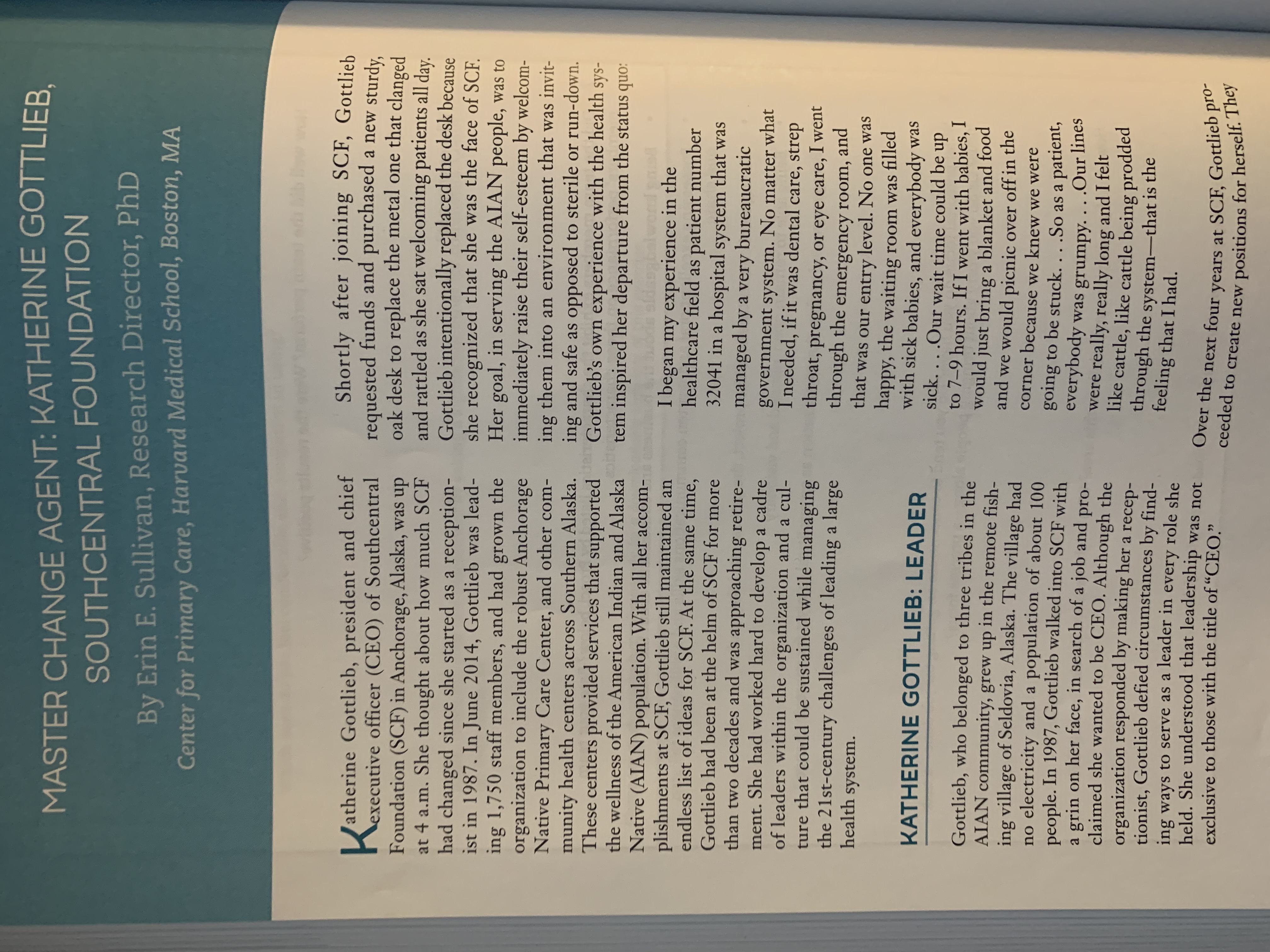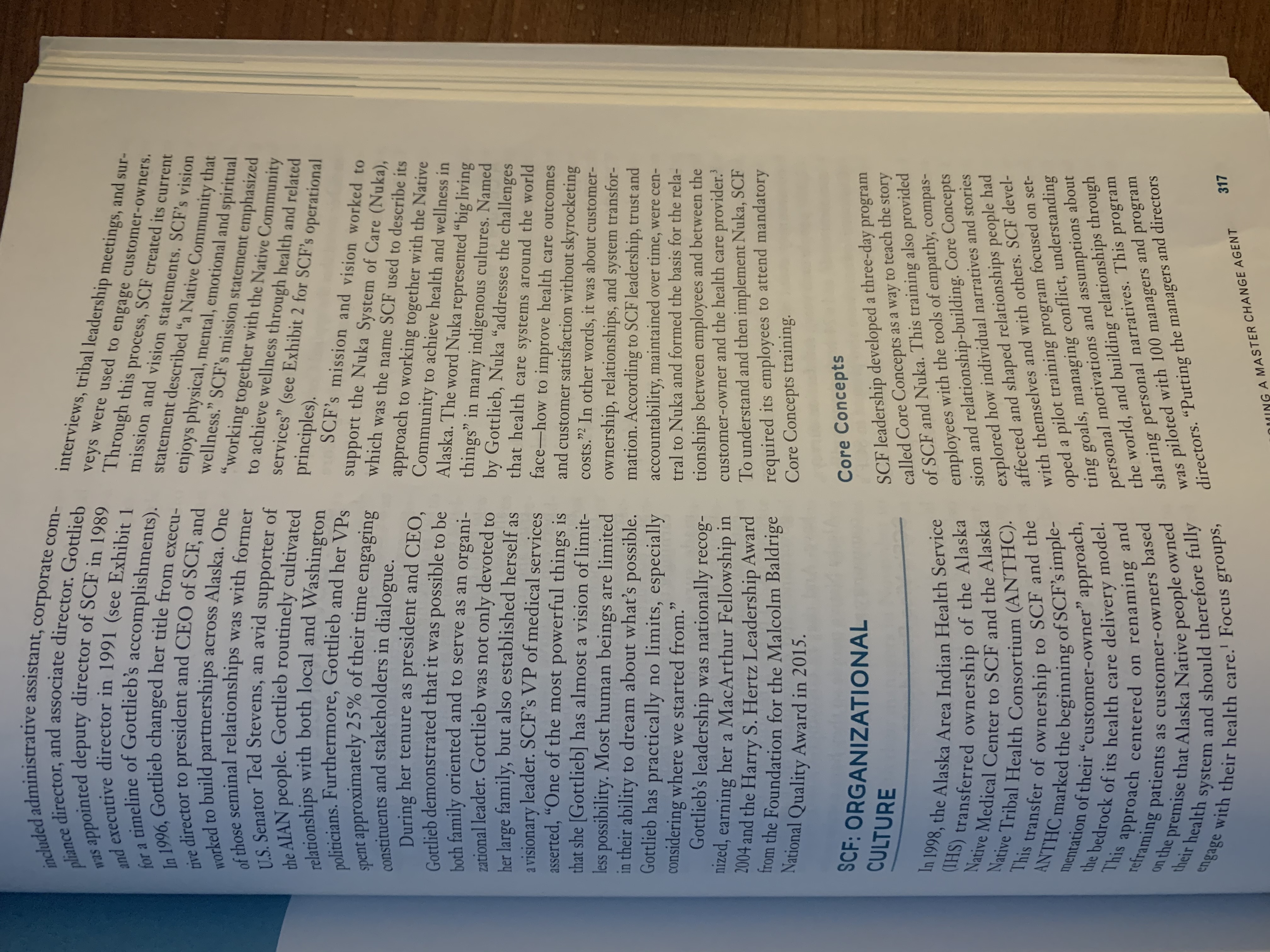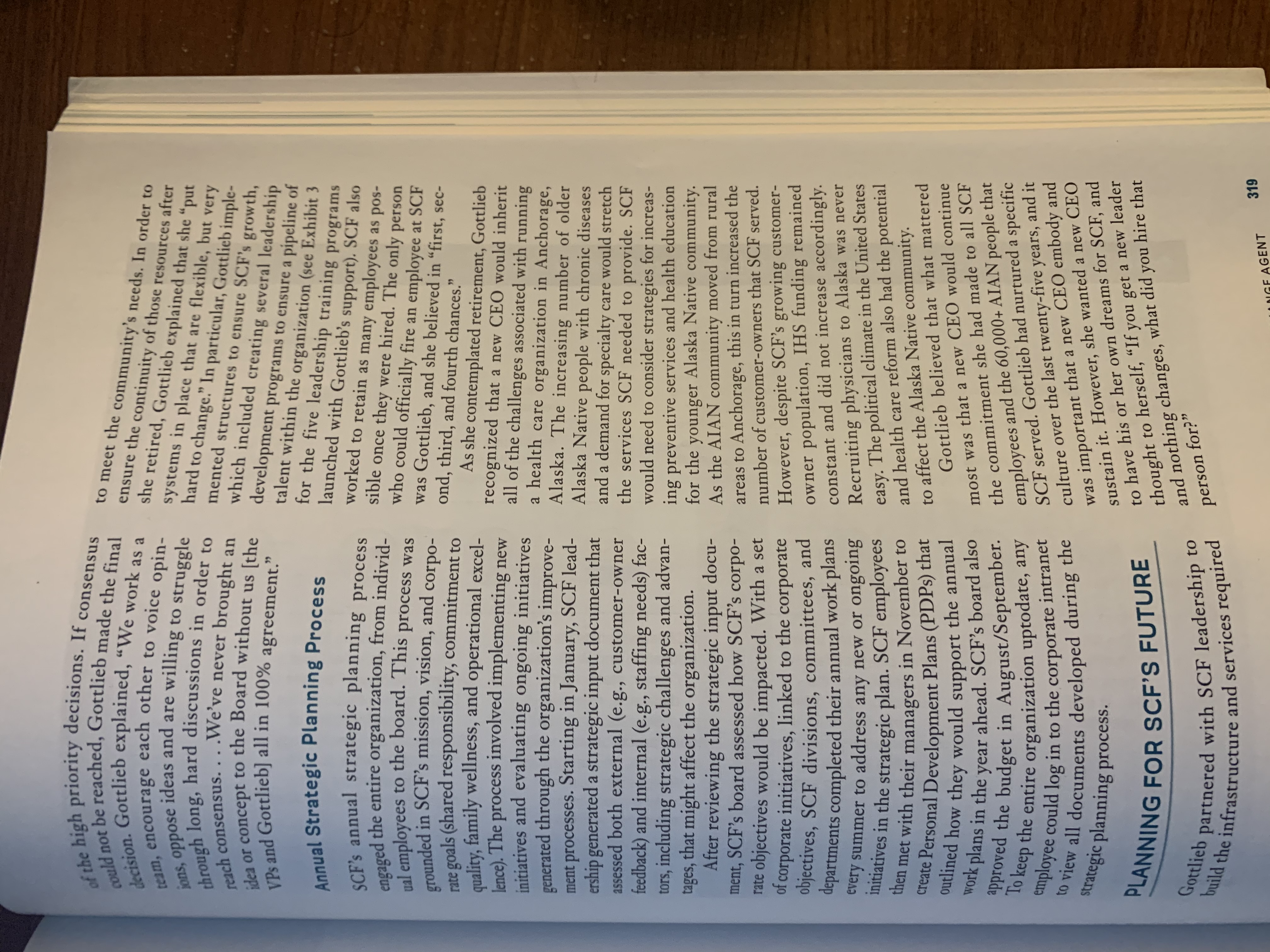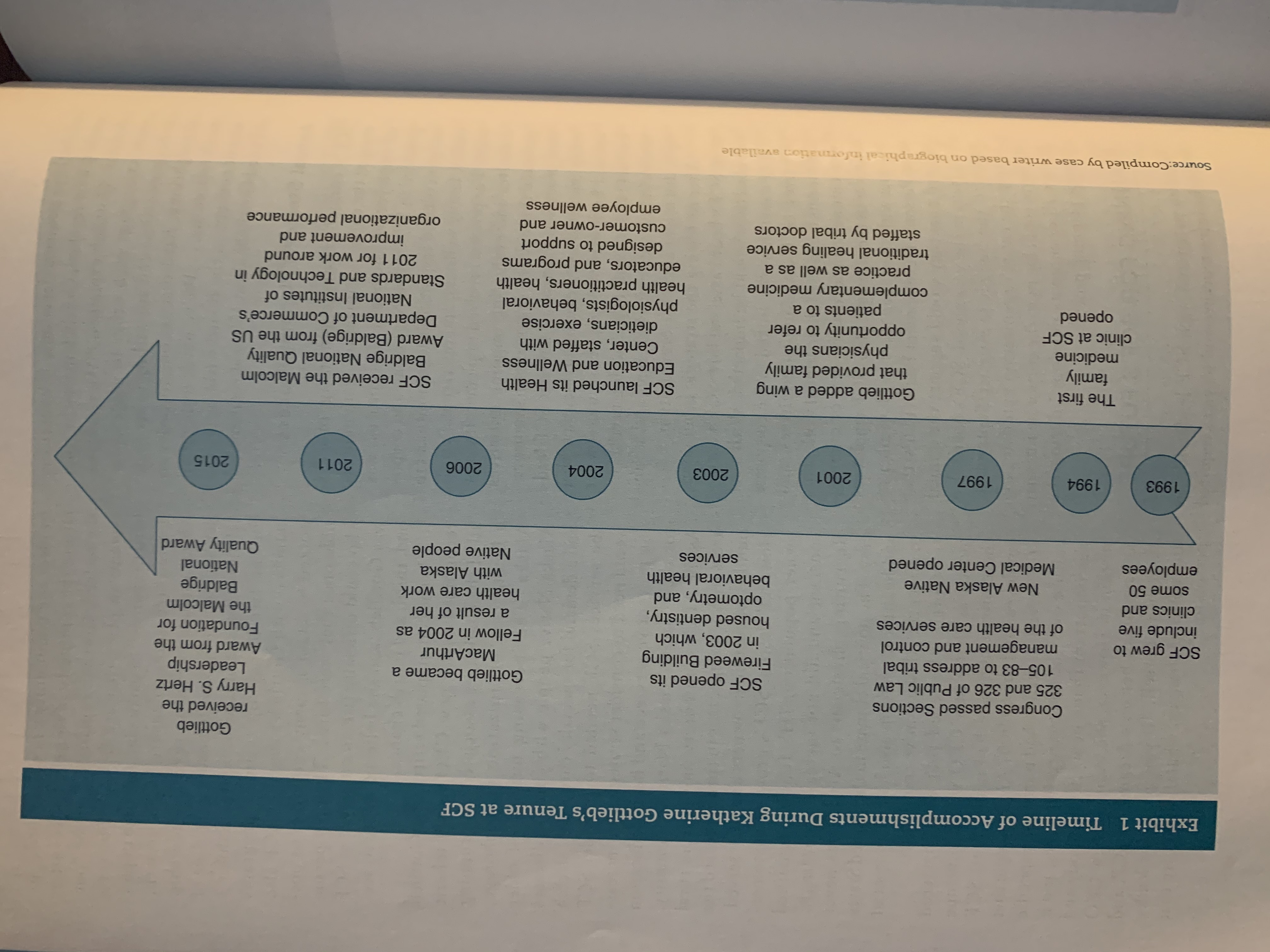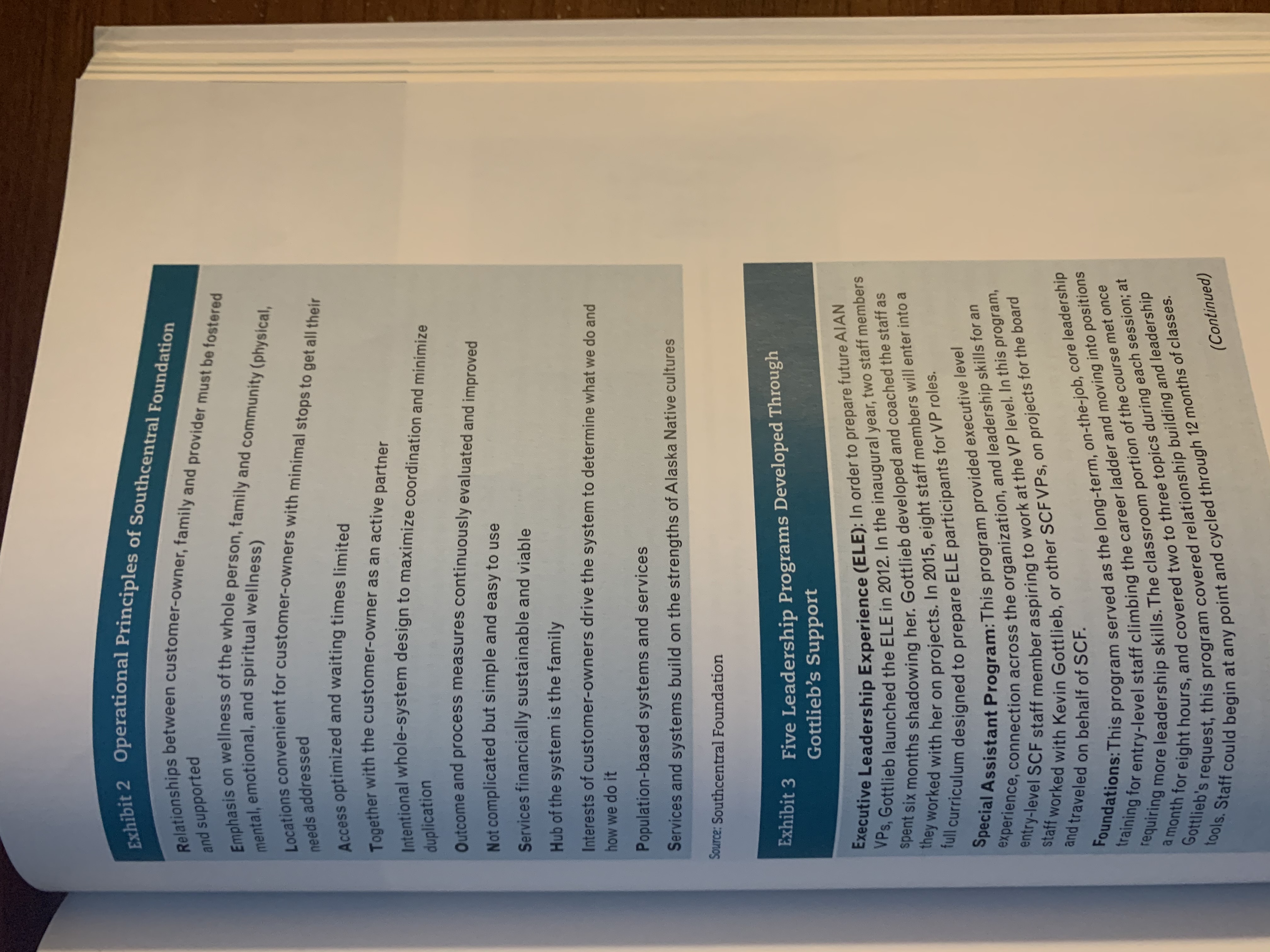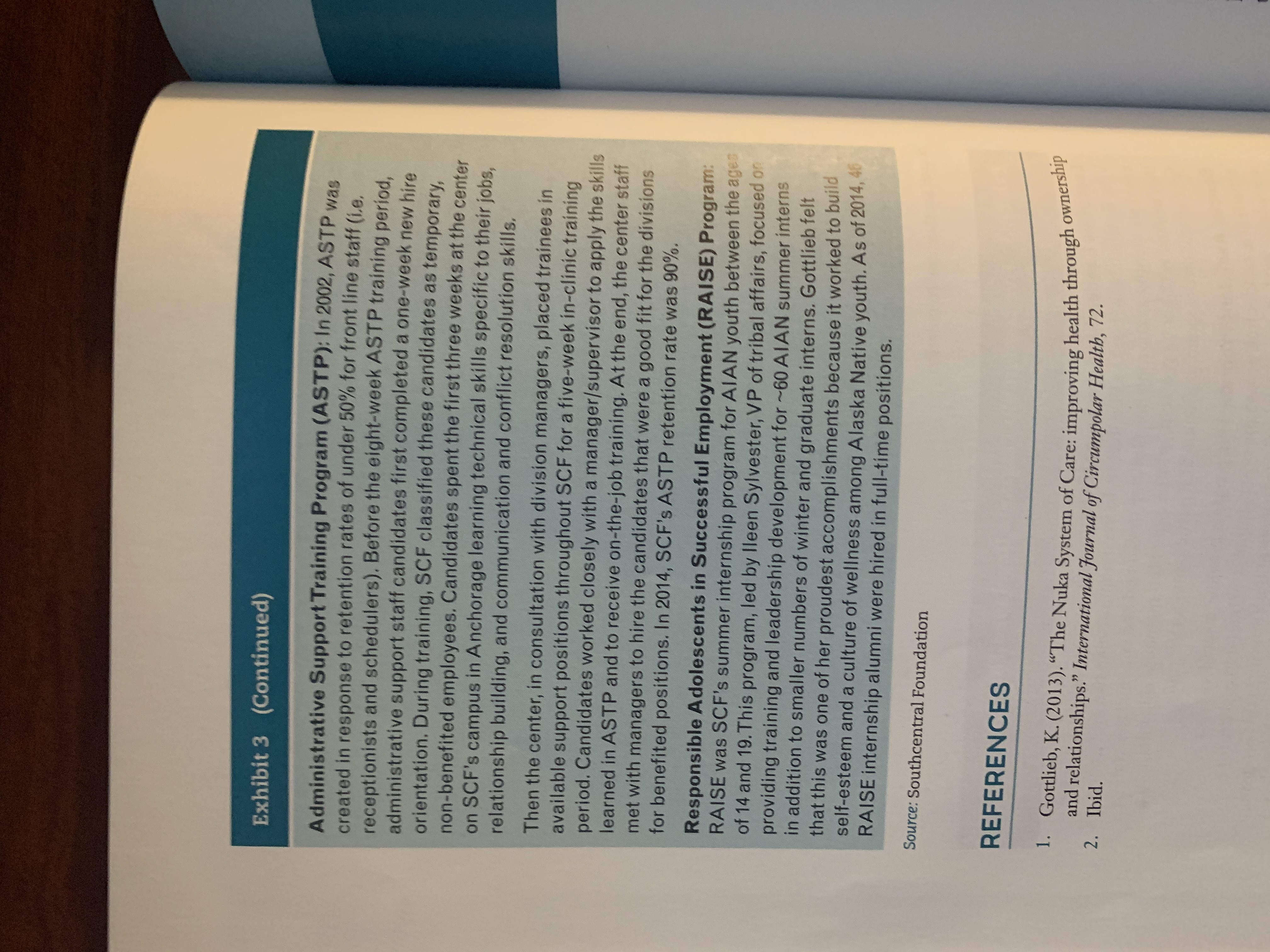MASTER CHANGE AGENT: KATHERINE GOTTLIEB, SOUTHCENTRAL FOUNDATION By Erin E. Sullivan, Research Director, PhD Center for Primary Care, Harvard Medical School, Boston, MA Katherine Gottlieb, president and chief Shortly after joining SCF, Gottlieb executive officer (CEO) of Southcentral requested funds and purchased a new sturdy, Foundation (SCF) in Anchorage, Alaska, was up oak desk to replace the metal one that clanged at 4 a.m. She thought about how much SCF and rattled as she sat welcoming patients all day. had changed since she started as a reception- Gottlieb intentionally replaced the desk because ist in 1987. In June 2014, Gottlieb was lead- she recognized that she was the face of SCF. ing 1,750 staff members, and had grown the Her goal, in serving the AIAN people, was to organization to include the robust Anchorage immediately raise their self-esteem by welcom- Native Primary Care Center, and other com- ing them into an environment that was invit- munity health centers across Southern Alaska. ing and safe as opposed to sterile or run-down. These centers provided services that supported Gottlieb's own experience with the health sys- the wellness of the American Indian and Alaska tem inspired her departure from the status quo: Native (AIAN) population. With all her accom- plishments at SCF, Gottlieb still maintained an I began my experience in the endless list of ideas for SCF. At the same time, healthcare field as patient number Gottlieb had been at the helm of SCF for more 32041 in a hospital system that was than two decades and was approaching retire- ment. She had worked hard to develop a cadre managed by a very bureaucratic of leaders within the organization and a cul- government system. No matter what ture that could be sustained while managing I needed, if it was dental care, strep the 21st-century challenges of leading a large throat, pregnancy, or eye care, I went health system. through the emergency room, and that was our entry level. No one was happy, the waiting room was filled KATHERINE GOTTLIEB: LEADER with sick babies, and everybody was sick. .. .Our wait time could be up Gottlieb, who belonged to three tribes in the to 7-9 hours. If I went with babies, I AIAN community, grew up in the remote fish- would just bring a blanket and food ing village of Seldovia, Alaska. The village had and we would picnic over off in the no electricity and a population of about 100 corner because we knew we were people. In 1987, Gottlieb walked into SCF with going to be stuck. .. .So as a patient, a grin on her face, in search of a job and pro- everybody was grumpy. .. .Our lines claimed she wanted to be CEO. Although the were really, really long and I felt organization responded by making her a recep- like cattle, like cattle being prodded tionist, Gottlieb defied circumstances by find- through the system-that is the ing ways to serve as a leader in every role she feeling that I had. held. She understood that leadership was not exclusive to those with the title of "CEO." Over the next four years at SCF, Gottlieb pro- ceeded to create new positions for herself. Theyincluded administrative assistant, corporate com- pliance director, and associate director. Gottlieb was appointed deputy director of SCF in 1989 and executive director in 199 interviews, tribal leadership meetings, and sur- (see Exhibit 1 for a timeline of Gottlieb's accomplishments). veys were used to engage customer-owners. In 1996, Gottlieb changed her title from execu- Through this process, SCF created its current mission and vision statements. SCF's vision tive director to president and CEO of SCF, and statement described "a Native Community that worked to build partnerships across Alaska. One enjoys physical, mental, emotional and spiritual of those seminal relationships was with former wellness." SCF's mission statement emphasized U.S. Senator Ted Stevens, an avid supporter of "working together with the Native Community the ALAN people. Gottlieb routinely cultivated to achieve wellness through health and related relationships with bot h both local and Washington services" (see Exhibit 2 for SCF's operational principles). politicians. Furthermore, Gottlieb and her VPs spent approximately 25% of their time engaging SCF's mission and vision worked to constituents and stakeholders in dialogue. support the Nuka System of Care (Nuka), which was the name SCF used to describe its During her tenure as president and CEO, approach to working together with the Native Gottlieb demonstrated that it was possible to be Community to achieve health and wellness in both family oriented and to serve as an organi- Alaska. The word Nuka represented "big living zational leader. Gottlieb was not only devoted to things" in many indigenous cultures. Named her large family, but also established herself as by Gottlieb, Nuka "addresses the challenges a visionary leader. SCF's VP of medical services that health care systems around the world asserted, "One of the most powerful things is face-how to improve health care outcomes that she [Gottlieb] has almost a vision of limit- and customer satisfaction without skyrocketing costs."? In other words, it was about customer- less possibility. Most human beings are limited ownership, relationships, and system transfor- in their ability to dream about what's possible. mation. According to SCF leadership, trust and Gottlieb has practically no limits, especially accountability, maintained over time, were cen- considering where we started from." tral to Nuka and formed the basis for the rela- Gottlieb's leadership was nationally recog tionships between employees and between the nized, earning her a MacArthur Fellowship in customer-owner and the health care provider.3 2004 and the Harry S. Hertz Leadership Award To understand and then implement Nuka, SCF from the Foundation for the Malcolm Baldrige required its employees to attend mandatory National Quality Award in 2015. Core Concepts training. SCF: ORGANIZATIONAL Core Concepts CULTURE SCF leadership developed a three-day program called Core Concepts as a way to teach the story In 1998, the Alaska Area Indian Health Service of SCF and Nuka. This training also provided (IHS) transferred ownership of the Alaska employees with the tools of empathy, compas- Cal Center to SCF and the Alaska sion and relationship-building. Core Concepts Native Medical Ce explored how individual narratives and stories Native Tribal Health Consortium (ANTHC). affected and shaped relationships people had This transfer of ownership to SCF and the with themselves and with others. SCF devel- ANTHC marked the beginning of SCF's imple- oped a pilot training program focused on set- mentation of their " customer-owner" approach, ting goals, managing conflict, understanding The bedrock of its health care delivery model. personal motivations and assumptions about This approach centered on renaming and the world, and building relationships through reframing patients as customer-owners based sharing personal narratives. This program premise that Alaska Native people owned was piloted with 100 managers and program gar health system and should therefore fully directors. "Putting the managers and directors engage with their health care.' Focus groups , 317 A MASTER CHANGE AGENTthrough the program was essential to achieve an average of 10 customer-owner comments buy-in for the concept," remembered Gottlieb. per day. Gottlieb explained that SCF's prac- Core Concepts officially started in 2008. tice was to act directly on the feedback and Once the majority of the workforce was trained, then close the loop with customer-owners. SCF offered Core Concepts three to four times Gottlieb elaborated: "We say we changed this annually. Gottlieb also conducted mini-sessions because you asked for it. We built this because to refresh Core Concepts principles for SCF you said to. Pretty soon you own the change, division and department leaders. Additionally, not us, not we who are working on the job." SCF put their operations on hold for an Annual SCF's customer-owner satisfaction rate con- Learning Event for all staff. One SCF staff sistently exceeded 90%. member noted that she applied Core Concepts outside of the workplace. Applying Core Concepts tools at home added to the holistic SCF: GOVERNANCE STRUCTURE wellness of the AIAN community, and provided a common language for healthy communication As Gottlieb expanded SCF, she reflected on its in families and relationships. governance structure and noted, "to be success- ful at working with a governance body, build- ing relationships is essential." Gottlieb worked A Culture of Improvement to build high trust and transparency throughout Gottlieb, along with her executive team, devel- all levels of the organization. She explained that oped a cultural and operational structure to trust and transparency were important not only support continuous change and improvement. between executive leadership and the board, SCF leadership had looked to corporations but also between the board and employees. like Disney and Ritz Carleton for best prac- To demonstrate her commitment to trust and tices in customer service, and created multiple transparency, Gottlieb removed the walls of the ways of soliciting and responding to feed- SCF boardroom and replaced them with glass- back from customer-owners. SCF received earning it the nickname "the fishbowl." Gottlieb customer-owner feedback via multiple chan- made sure that the SCF Board remained nels, including iPads placed in primary care involved in SCF events, from special visits from clinics, social media platforms, direct emails external organizations to celebrations. Gottlieb to Gottlieb, the Gathering (an annual SCF reported, "There's a relationship between the community event attended by more than governance and community of employees we 2,000 people each year), satisfaction surveys, have. And they're customer-owners-they're comment cards, and a 24-hour phone hotline. Alaska Native people so they have a stake in the Customer-owners were also present in SCF's community and that's a pretty big deal." workforce (50 -60%) and were another valu- able source of feedback. SCF's joint operat- SCF's Vice Presidents ing boards and advisory committees, entirely comprised of customer-owners, periodically Gottlieb's executive team had all "grown up" met with SCF's senior leadership team. in the organization together. Joining SCF According to an SCF improvement between 1980 and 1996, the VPs had exten- advisor, this constant feedback loop within sive knowledge of the organization having SCF empowered staff to think constantly served in various administrative and clini- about improvement and a culture of change. cal roles before assuming leadership posi Improvement work was an essential part of tions as VPs. All six VPs reported to Gottlieb every job function at SCF, and the organiza- and were housed in the same location. She tion provided ongoing training opportuni- stated, "SCF's VPs are all located in the same ties so that every employee could meet that area so they interact as a tea a team and have easy expectation. SCF received and responded to access to one another." She met with SCF's VPs frequently, and the group made manyof the high priority decisions. If consensus could not be reached, Gottlieb made the final decision. Gottlieb explained, "We work as a team , encourage each other to to meet the community's needs. In order to ions, oppose ideas and are willing er to voice opin- ensure the continuity of those resources after illing to struggle she retired, Gottlieb explained that she "put through long, hard discussions in order to systems in place that are flexible, but very reach consensus. .. .We've never brought an hard to change." In particular, Gottlieb imple- idea or concept to the Board without us [the mented structures to ensure SCF's growth, VPs and Gottlieb] all in 100% agreement." which included creating several leadership development programs to ensure a pipeline of Annual Strategic Planning Process talent within the organization (see Exhibit 3 for the five leadership training programs SCF's annual strategic planning process launched with Gottlieb's support). SCF also engaged the entire organization, from individ- worked to retain as many employees as pos- ual employees to the board. This process was sible once they were hired. The only person grounded in SCF's mission, vision, and corpo- who could officially fire an employee at SCF rate goals (shared responsibility, commitment to was Gottlieb, and she believed in "first, sec- ond, third, and fourth chances.' quality, family wellness, and operational excel- lence). The process involved implementing new As she contemplated retirement, Gottlieb recognized that a new CEO would inherit initiatives and evaluating ongoing initiatives all of the challenges associated with running generated through the organization's improve- a health care organization in Anchorage, ment processes. Starting in January, SCF lead- Alaska. The increasing number of older ership generated a strategic input document that Alaska Native people with chronic diseases assessed both external (e.g., customer-owner and a demand for specialty care would stretch feedback) and internal (e.g., staffing needs) fac- the services SCF needed to provide. SCF tors, including strategic challenges and advan- would need to consider strategies for increase tages, that might affect the organization. ing preventive services and health education After reviewing the strategic input docu- for the younger Alaska Native community. As the AIAN community moved from rural ment, SCF's board assessed how SCF's corpo- areas to Anchorage, this in turn increased the rate objectives would be impacted. With a set number of customer-owners that SCF served. of corporate initiatives, linked to the corporate However, despite SCF's growing customer- objectives, SCF divisions, committees, and owner population, IHS funding remained departments completed their annual work plans constant and did not increase accordingly. every summer to address any new or ongoing Recruiting physicians to Alaska was never initiatives in the strategic plan. SCF employees easy. The political climate in the United States then met with their managers in November to and health care reform also had the potential create Personal Development Plans (PDPs) that to affect the Alaska Native community. outlined how they would support the annual Gottlieb believed that what mattered work plans in the year ahead. SCF's board also most was that a new CEO would continue approved the budget in August/September. the commitment she had made to all SCF To keep the entire organization uptodate, any employees and the 60,000+ AIAN people that employee could log in to the corporate intranet SCF served. Gottlieb had nurtured a specific to view all documents developed during the culture over the last twenty-five years, and it was important that a new CEO embody and strategic planning process. sustain it. However, she wanted a new CEO PLANNING FOR SCF'S FUTURE to have his or her own dreams for SCF, and thought to herself, "If you get a new leader and nothing changes, what did you hire that Gottlieb partnered with SCF leadership to build the infrastructure and services required person for?" AGENT 319Exhibit 1 Timeline of Accomplishments During Katherine Gottlieb's Tenure at SCF Gottlieb received the Congress passed Sections Harry S. Hertz 325 and 326 of Public Law SCF opened its Gottlieb became a Leadership 105-83 to address tribal Fireweed Building MacArthur Award from the SCF grew to management and control in 2003, which Fellow in 2004 as Foundation for include five of the health care services housed dentistry, a result of her the Malcolm clinics and optometry, and health care work Baldrige some 50 New Alaska Native behavioral health with Alaska National employees Medical Center opened services Native people Quality Award 1993 1994 1997 2001 2003 2004 2006 2011 2015 The first Gottlieb added a wing SCF launched its Health SCF received the Malcolm family that provided family Education and Wellness Baldrige National Quality medicine physicians the Center, staffed with Award (Baldrige) from the US clinic at SCF opportunity to refer dieticians, exercise Department of Commerce's opened patients to a physiologists, behavioral National Institutes of complementary medicine health practitioners, health Standards and Technology in practice as well as a educators, and programs 2011 for work around traditional healing service designed to support improvement and staffed by tribal doctors customer-owner and organizational performance employee wellness Source:Compiled by case writer based on biographical information availableExhibit 2 Operational Principles of Southcentral Foundation and supported Relationships between customer-owner, family and provider must be fostered Emphasis on wellness of the whole person, family and community (physical, mental, emotional, and spiritual wellness) Locations convenient for customer-owners with minimal stops to get all their needs addressed Access optimized and waiting times limited Together with the customer-owner as an active partner duplication Intentional whole-system design to maximize coordination and minimize Outcome and process measures continuously evaluated and improved Not complicated but simple and easy to use Services financially sustainable and viable Hub of the system is the family how we do it Interests of customer-owners drive the system to determine what we do and Population-based systems and services Services and systems build on the strengths of Alaska Native cultures Source: Southcentral Foundation Exhibit 3 Five Leadership Programs Developed Through Gottlieb's Support Executive Leadership Experience (ELE): In order to prepare future AIAN VPs, Gottlieb launched the ELE in 2012. In the inaugural year, two staff members spent six months shadowing her. Gottlieb developed and coached the staff as they worked with her on projects. In 2015, eight staff members will enter into a full curriculum designed to prepare ELE participants for VP roles. Special Assistant Program: This program provided executive level experience, connection across the organization, and leadership skills for an entry-level SCF staff member aspiring to work at the VP level. In this program, staff worked with Kevin Gottlieb, or other SCFVPs, on projects for the board and traveled on behalf of SCF. Foundations: This program served as the long-term, on-the-job, core leadership Training for entry-level staff climbing the career ladder and moving into positions requiring more leadership skills. The classroom portion of the course met once amonth for eight hour ight hours, and covered two to three topics during each session; at Gottlieb's request, this program covered relationship building and leadership tools. Staff could begin at any point and cycled through 12 months of classes. (Continued)Exhibit 3 (Continued) Administrative Support Training Program (ASTP): In 2002, ASTP was created in response to retention rates of under 50% for front line staff (i.e. receptionists and schedulers). Before the eight-week ASTP training period, administrative support staff candidates first completed a one-week new hire orientation. During training, SCF classified these candidates as temporary, non-benefited employees. Candidates spent the first three weeks at the center on SCF's campus in Anchorage learning technical skills specific to their jobs, relationship building, and communication and conflict resolution skills. Then the center, in consultation with division managers, placed trainees in available support positions throughout SCF for a five-week in-clinic training period. Candidates worked closely with a manager/supervisor to apply the skills learned in ASTP and to receive on-the-job training. At the end, the center staff met with managers to hire the candidates that were a good fit for the divisions for benefited positions. In 2014, SCF's ASTP retention rate was 90%. Responsible Adolescents in Successful Employment (RAISE) Program: RAISE was SCF's summer internship program for AIAN youth between the ages of 14 and 19. This program, led by lleen Sylvester, VP of tribal affairs, focused on providing training and leadership development for ~60 AIAN summer interns in addition to smaller numbers of winter and graduate interns. Gottlieb felt that this was one of her proudest accomplishments because it worked to build self-esteem and a culture of wellness among Alaska Native youth. As of 2014, 46 RAISE internship alumni were hired in full-time positions. Source: Southcentral Foundation REFERENCES 1. Gottlieb, K. (2013). "The Nuka System of Care: improving health through ownership 2. Ibid. and relationships." International Journal of Circumpolar Health, 72
